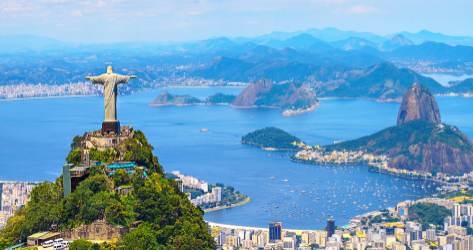- Adventure: A waterfall five times larger than that of Niagara
- Album: The 10 most spectacular natural destinations in South America
On December 13, 1519, the expedition led by Fernando de Magallanes - the same one that would make Juan Sebastián Elcano take the first trip around the world - arrived after four months of navigation to his first overseas port. Having set aside the north star, the five ships financed by the Spanish Crown threw the anchor in Guanabara Bay , where the Portuguese founded, in 1565, the city of Rio de Janeiro.
Today, five hundred years later, the Spanish Navy school ship that receives its name in honor of the Basque sailor docks in those same waters, within the framework of the celebrations of the V Centenary of the first circumnavigation of History, epic that culminated an 8 September 1922, in Seville.
In addition to Brazil hosting the commemoration of the event, the arrival of the training ship, which incorporates for the first time a scientific dimension to its program to analyze the marine temperature and the presence of plastics and other wastes, involves other important issues. In the first place, "as a ship-school because it allows the completion of the first stage of training of the midshipmen in their naval career," explains its commander, the frigate captain Santiago de Colsa.
For him, there is a "strong link between Spain and Brazil, two sister nations in the Ibero-American community, which share a strong maritime dimension." Thus, "Brazilians and Spaniards, when we live facing the sea, we are able to set up entrepreneurial, open, dynamic, welcoming societies," adds de Colsa.
On the other hand, the midshipmen "learn the weight of history." Well, he continues, "we are heirs of a story that allows us to remember that 500 years ago a Spanish expedition under Fernando de Magallanes arrived in Guanabara Bay and that it was the last pleasant and pleasant stopover they found in what would later be the greatest epic in the maritime history of the world, the first circumnavigation already under the command of the great Spanish sailor Juan Sebastián Elcano ".
RUMBO TO LA PLATA RIVER
And it is that from this milestone, "the sea is configured as a meeting place among all the peoples of the Earth," concludes the commander of Elcano that on Sunday will sail, as 500 years ago, heading to the Río de la Plata, with stops in Buenos Aires and Montevideo.
He will have left behind several events organized by the Spanish consulate in Rio, such as the V Centenário primeira seminar volta ao mundo. A stay in Rio de Janeiro does not rub , in the National Historical Museum, with the presence of experts from Brazil, Spain, Portugal, Argentina, Chile and Uruguay; or a Spanish-Brazilian business forum, in which executives of Spanish and Brazilian companies have participated, and which has had the presence of the Spanish Secretary of State for Commerce.
And it is that, as the Spanish consul in Rio, Luis Prados Covarrubias, points out, these activities "that are being carried out on the occasion of the commemoration of the V Centenary of the arrival in Guanabara Bay of the Magallanes-Elcano expedition, by a on the one hand, they show the close relations between the two countries in all fields: cultural, social, economic, etc. And, on the other, they offer opportunities to launch new projects that will contribute to further strengthen these relations. "
Round trip
In the same way that Elcano opens its doors for visits, Spain celebrates the arrival of the expedition to Brazil through the Rio we are nos! in the National Museum of Anthropology of Madrid. In collaboration with various museums in the city of Fluminense, the temporary exhibition (free admission until February 16) celebrates the spirit of Rio de Janeiro.
Far from staying in the cliché of beach and samba , football and cachaça , the exhibition about Rio de Janeiro through its communities, neighborhoods battered by historical omission, violence and poverty. Thus, they are their own museums -Museu da Maré, the Favela Museum, the Sankofa Museum, the Corá Hill Museum, the São Bento Live Museum, the Remoções Museum, the Sepetiba Ecomuseu, the Gericino Buu Meu Boi Raízes Museum and the Ecomuseu de Santa Cruz - the ones in charge of showing the multiple reality of the Wonderful City.
| More information on the celebrations of the V Centenary of the first round the world in vcentenario.es
According to the criteria of The Trust Project
Know more- Brazil
- Spain
- tourism
HISTORYa (curious) route of the Borja through Valencian lands
El Caminante Landscapes, cities, routes, monuments and essential appointments to enjoy the December bridge in Andalusia
OFFERSHow to buy airline tickets for half the price

